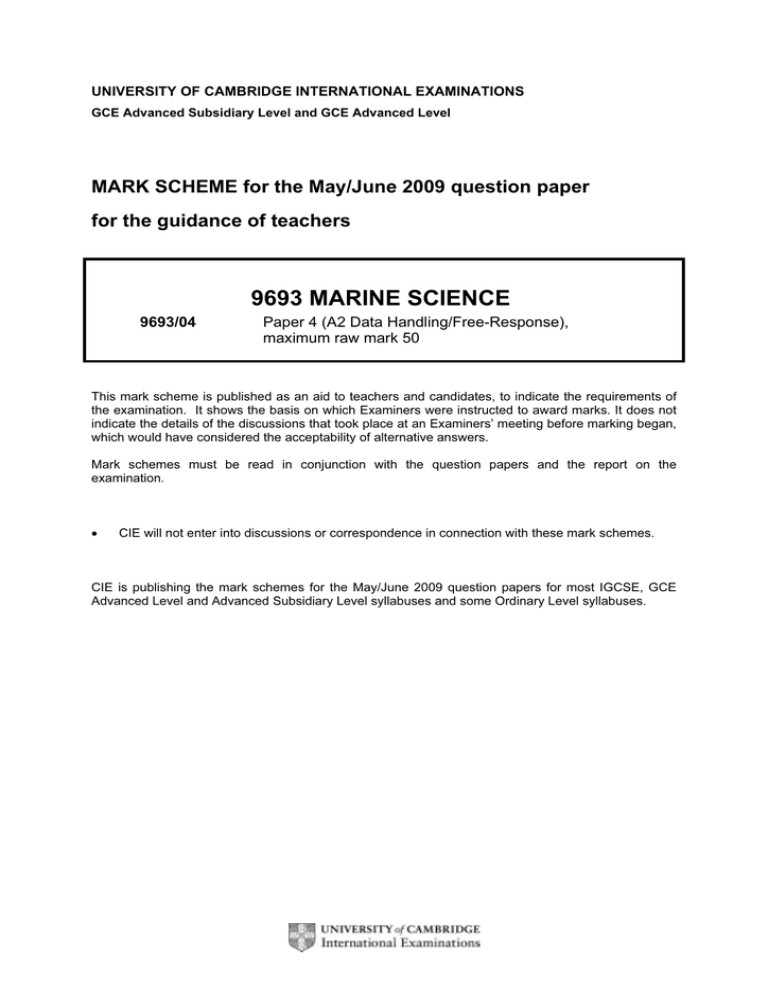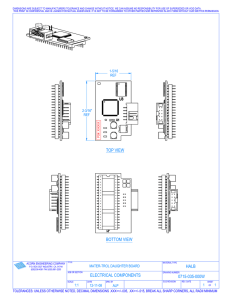9693 MARINE SCIENCE
advertisement

UNIVERSITY OF CAMBRIDGE INTERNATIONAL EXAMINATIONS GCE Advanced Subsidiary Level and GCE Advanced Level MARK SCHEME for the May/June 2009 question paper for the guidance of teachers 9693 MARINE SCIENCE 9693/04 Paper 4 (A2 Data Handling/Free-Response), maximum raw mark 50 This mark scheme is published as an aid to teachers and candidates, to indicate the requirements of the examination. It shows the basis on which Examiners were instructed to award marks. It does not indicate the details of the discussions that took place at an Examiners’ meeting before marking began, which would have considered the acceptability of alternative answers. Mark schemes must be read in conjunction with the question papers and the report on the examination. • CIE will not enter into discussions or correspondence in connection with these mark schemes. CIE is publishing the mark schemes for the May/June 2009 question papers for most IGCSE, GCE Advanced Level and Advanced Subsidiary Level syllabuses and some Ordinary Level syllabuses. Page 2 1 Mark Scheme: Teachers’ version GCE A/AS LEVEL – May/June 2009 Syllabus 9693 Paper 04 (a) none, very low north of 60N / south of 60S ; rises south of 60N / north of 60S ; ref. to plateau / 30N to 30S ; peaks 40N ; [3 max] (b) ref. to low production due lack of nutrients on equator ; despite warmer water ; ref. to upwelling in southern waters ; nutrient rich water ; [3 max] (c) rises until end of May / June ; then falls until mid September ; rises again until November ; [2 max] (d) April / May July ref. to predation by zooplankton ; ref. to shortage of nutrients / nutrients used up ; reduction in zooplankton numbers / less predation by zooplankton ; ref. to summer upwelling of nutrients ; [2 max] [Total: 10] 2 (a) ref. to mangroves cut down to build ponds ; ref. to pollution from run off ; [2] (b) larger ponds have lower yield ; quote figures 2 to 100 yield 50–500 while 0.1 to 1.5 yield 5000–20000 ; [2] (c) extensive intermediate intensive larger ponds ; larger areas required ; greater loss of natural habitats / mangroves ; more shrimps in ponds so more potential pollution ; damage caused in production of food pellets ; greater concentration of shrimps in ponds so more potential pollution ; greater potential for disease ; damage caused in production of food pellets ; [3 max] (d) (i) Total number of shrimp in the pond = (3,000 × 60) / (5 × 3) = 12,000 ; (ii) Average body mass = 600 / 60 = 10 g no marks awarded for this part calculation required for (iii) (iii) Total mass of shrimps in the pond = 12,000 × 10 = 120,000 g = 120 kg ; (iv) Total feed per day = 120 × 2.0 / 100 = 2.4 kg ; [3] [Total: 10] © UCLES 2009 Page 3 3 Mark Scheme: Teachers’ version GCE A/AS LEVEL – May/June 2009 Syllabus 9693 Paper 04 (a) ref. TBT causes imposex in mollusks ; females develop some male genitalia, including a penis and vas deferens superimposed on the female reproductive system / sterility can occur in severe cases ; concentrations as low as a few parts-per-trillion can cause the problem ; possible catastrophic consequences to marine ecosystems through the potential removal of a vital part of the food chain / ref. to predatory gastropods ; ref. use of heavy metals ; ref. to biological magnification in food chain ; [2 max] (b) warmer seawater – coral bleaching ; coral expel zooanthellae ; leading to death of coral ; ref. to reef structure weakened ; loss of fish species ; rise in sea level may stimulate growth of corals ; expansion of area of coral reefs ; increase rate of calcification ; carbon dioxide increase ; acidification of oceans ; reduce ability of coral polyps to deposit calcium carbonate ; ref. to increase risk of disease ; more storms / rainfall ; increase in suspended sediment ; re. blocking light / prevent feeding of polyps ; (c) changes observed during the period of instrumental temperature record ; when records are most reliable; particularly on the last 50 years ; when human activity has grown fastest / ref. industrial revolution ; observations of the upper atmosphere have become available ; increasing atmospheric concentrations of greenhouse gases ; global changes to land surface, such as deforestation ; increasing atmospheric concentrations of aerosols ; [8 max] [5 max] [Total: 15] 4 (a) size increase sa/v ratio decrease ; example / calculation using spheres or cubes ; ref. to shape ; [2 max] (b) diffusion not adequate ; as not enough area (relative to volume) ; ora distance too great ; cells deep in body ; mass flow system needed ; ref. to pumping / heart ; transport / blood (vascular), systems ; link, the parts of the body / named parts ; e.g. of substance needing to be transported ; ref to activity / high metabolic rate, of large active animals ; [8 max] © UCLES 2009 Page 4 (c) coral polyps Mark Scheme: Teachers’ version GCE A/AS LEVEL – May/June 2009 Syllabus 9693 Paper 04 simple diffusion ; over whole body surface ; reference to diploblastic / only two body layers ; short diffusion distance / contact with sea water ; ref. to activity / metabolic rate low ; grouper pumped ventilation ; buccal pump ; gills ; filled with blood / ref. capillaries ; pumped around body by heart ; ref. to activity / metabolic rate high ; tuna ram ventilation ; force generated by swimming ; gills ; filled with blood ; pumped around body by heart ; ref. to activity / metabolic rate high ; [5 max] [Total: 15] © UCLES 2009



